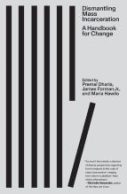Dismantling Mass Incarceration: A Handbook for Change
 Authors: Premal Dharia, James Forman Jr., & Maria Hawilo
Authors: Premal Dharia, James Forman Jr., & Maria Hawilo
Publisher: FSG Originals (Macmillan Publishers), 2024. 496 pages.
Reviewer: Sheldon Evans | Winter 2025
Justice Sonya Sotomayor described her time as a prosecutor by saying that the criminal justice system “accomplishes nothing we think of as its purpose” because “[w]e think we’re keeping people safe from criminals” when we are actually “just making worse criminals.” (98–99) Justice Sotomayor’s critique is a dominant theme that is captured by Dismantling Mass Incarceration: A Handbook for Change. This volume is a collection of writings collated by editors Premal Dharia, James Forman, Jr., and Maria Hawilo in their attempt to create a one-stop-shop for anybody interested in discussing solutions for the mass incarceration crisis. In the words of Angela Davis, “[t]hese challenges will vary by jurisdiction, experience, and background, and thus so will the strategies for addressing them.” (107) This book represents one of the few attempts to comprehensively consider the diversity of solutions needed to dismantle the institution of mass incarceration.
The contributions of this volume are primarily editorial in nature. First, the book is geared towards a specific audience. The title says it all: this is not a book that is meant to discuss the nuances of mass incarceration; it is a book that is meant to appeal to people that already accept that mass incarceration is a problem. Readers must go elsewhere to find opinions justifying the status quo of policing, or a cost-benefit analysis for prisons. Instead, this is a book that is intended to educate and inspire the next generation of students, lawyers, and activists towards change.
Second, the collected writings show a strong commitment to the intellectual diversity of the authors. It collects short writings and excerpts from abolitionist activists, reporters, judges, prosecutors, incarcerated persons, and others. And even though many professors are excerpted in this book, their scholarship is not. The editors made the decision to focus on the more popular book or media writings of these experts rather than their more complicated and esoteric scholarship. Activist calls to action, interviews with experts, and even a twitter thread create a unique volume of voices that are rarely in conversation with another. This editorial creativity creates a rich intellectual discussion that escapes the ivory tower and sits with people where they interact with these issues.
Third, the collected writings suffer from a recency bias that is undoubtedly intentional. Most of the writings (48 of 55) are from after 2015, with over half of them written after 2020. This creates an underlying assumption that the best writings on the topics of change are those written within the past five to ten years. I disagree with this underlying assumption, because scholars and advocates have been contributing radical and prescient ideas to this literature since the 1970s. Indeed, many of these foundational texts inspired the writings that were selected for this book. Perhaps this is a nod from the editors to use the most accessible and relatable writings to inspire the next generation. An essay written in 2021 might be more pressing and powerful than one written in 1991. And when the book is already pushing over 450 pages, it is understandable that the editors prioritized a theme or recency over chronological variety.
The substance of the collected writings shows a strong organizational ethos of the systemic and institutional problems of the criminal justice system. The book’s six parts each take on a different institutional actor that contributes to the system, proposing a host of approaches and solutions for each category. There are simply too many topics to discuss given the sheer scope of substantive, procedural, and practical issues. But there were some recurring themes that the editors carefully curated. For policing, state vs. community action is an important discussion. (31, 40) When discussing the legitimacy of police forces and the public safety and damage they provide (27), many have questioned whether the community is better suited to protect itself. For prosecutors, the editors captured the power vs. accountability dichotomy. If prosecutors are indeed among the most powerful actors in the system, then why is there so little accountability when they violate constitutional rights or fill up prisons with little financial, ethical, or political consequences (77, 130)? For defense counsel, there was both sympathy and derision, showing that it is almost impossible to win; these attorneys are sympathetic because they are tasked with representing people in poverty and must give voice to their stories (168, 215), but are also participating in and legitimizing a system that is built to victimize the victimizers. (185) For judges, their power to hold lawyers accountable in their courtroom, as well as their purview over bail decisions shows that they are more than neutral arbiters but can be agents of change. (244, 250). For prisons, abolitionist literature was contrasted with reformist approaches, all in the shadow of bipartisan agreement that too many people are incarcerated in Red and Blue states alike. (336) For the aftermath, the editors captured how the system produces recidivism by imposing permanent punishments even after a convicted person has served their official sentence. (385, 410) Familiar tropes of race, class, and penal populism are weaved throughout, but unfortunately not prioritized as their own standalone sections. Perhaps these tropes are too familiar; these things have been discussed ad nauseum in the scholarly and activist literature, so perhaps the editors though it best to take a fresh approach to inspire fresh solutions.
Dismantling Mass Incarceration is a valuable volume for students, scholars, and activists alike. It is a ready-made textbook for many professors seeking to pull together innovative and thought-provoking materials for a seminar or class on the criminal justice system. I imagine it will become a mainstay among teachers for the next decade, similar to The New Jim Crow and The American Prison. It is a treasure trove for popular press writings on the pressing issues of mass incarceration and how to think about solving them.
In closing, I tend to agree with Ghettoside author Jill Levoy when she said that “[w]hat bothers [her] the most, on both sides, is those who behave as if we have all the answers. We don’t.” (26) Dismantling Mass Incarceration, however, brings us one step closer to finding them.
Sheldon Evans is a Professor of Law at the Washington University School of Law.


